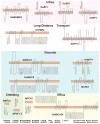Metalloprotein-Specific or Critical Amino Acid Residues: Perspectives on Plant-Precise Detoxification and Recognition Mechanisms under Cadmium Stress
- PMID: 35163656
- PMCID: PMC8836122
- DOI: 10.3390/ijms23031734
Metalloprotein-Specific or Critical Amino Acid Residues: Perspectives on Plant-Precise Detoxification and Recognition Mechanisms under Cadmium Stress
Abstract
Cadmium (Cd) pollution in cultivated land is caused by irresistible geological factors and human activities; intense diffusion and migration have seriously affected the safety of food crops. Plants have evolved mechanisms to control excessive influx of Cd in the environment, such as directional transport, chelation and detoxification. This is done by some specific metalloproteins, whose key amino acid motifs have been investigated by scientists one by one. The application of powerful cell biology, crystal structure science, and molecular probe targeted labeling technology has identified a series of protein families involved in the influx, transport and detoxification of the heavy metal Cd. This review summarizes them as influx proteins (NRAMP, ZIP), chelating proteins (MT, PDF), vacuolar proteins (CAX, ABCC, MTP), long-distance transport proteins (OPT, HMA) and efflux proteins (PCR, ABCG). We selected representative proteins from each family, and compared their amino acid sequence, motif structure, subcellular location, tissue specific distribution and other characteristics of differences and common points, so as to summarize the key residues of the Cd binding target. Then, we explain its special mechanism of action from the molecular structure. In conclusion, this review is expected to provide a reference for the exploration of key amino acid targets of Cd, and lay a foundation for the intelligent design and breeding of crops with high/low Cd accumulation.
Keywords: Cd transport and detoxification; H/DXXXD; cysteine-related residues; functional protein.
Conflict of interest statement
The authors declare that there is no conflict of interests regarding the publication of this paper.
Figures


Similar articles
-
Metal transport proteins and transcription factor networks in plant responses to cadmium stress.Plant Cell Rep. 2024 Aug 17;43(9):218. doi: 10.1007/s00299-024-03303-x. Plant Cell Rep. 2024. PMID: 39153039 Review.
-
From stress to resilience: Unraveling the molecular mechanisms of cadmium toxicity, detoxification and tolerance in plants.Sci Total Environ. 2024 Dec 1;954:176462. doi: 10.1016/j.scitotenv.2024.176462. Epub 2024 Sep 25. Sci Total Environ. 2024. PMID: 39332719 Review.
-
The Uptake, Transfer, and Detoxification of Cadmium in Plants and Its Exogenous Effects.Cells. 2024 May 24;13(11):907. doi: 10.3390/cells13110907. Cells. 2024. PMID: 38891039 Free PMC article. Review.
-
[Molecular mechanisms of plant resistance to cadmium toxicity].Ying Yong Sheng Tai Xue Bao. 2006 Jun;17(6):1112-6. Ying Yong Sheng Tai Xue Bao. 2006. PMID: 16964952 Review. Chinese.
-
Do heavy metals and metalloids influence the detoxification of organic xenobiotics in plants?Environ Sci Pollut Res Int. 2009 Nov;16(7):795-804. doi: 10.1007/s11356-009-0168-7. Epub 2009 May 22. Environ Sci Pollut Res Int. 2009. PMID: 19462193
Cited by
-
Abscisic-Acid-Regulated Responses to Alleviate Cadmium Toxicity in Plants.Plants (Basel). 2023 Feb 23;12(5):1023. doi: 10.3390/plants12051023. Plants (Basel). 2023. PMID: 36903884 Free PMC article. Review.
-
Identification of the Major Effector StSROs in Potato: A Potential StWRKY-SRO6 Regulatory Pathway Enhances Plant Tolerance to Cadmium Stress.Int J Mol Sci. 2022 Nov 18;23(22):14318. doi: 10.3390/ijms232214318. Int J Mol Sci. 2022. PMID: 36430795 Free PMC article.
-
Utilization of Antagonistic Interactions Between Micronutrients and Cadmium (Cd) to Alleviate Cd Toxicity and Accumulation in Crops.Plants (Basel). 2025 Feb 26;14(5):707. doi: 10.3390/plants14050707. Plants (Basel). 2025. PMID: 40094627 Free PMC article. Review.
-
Chemical Synthesis and Insecticidal Activity Research Based on α-Conotoxins.Molecules. 2024 Jun 14;29(12):2846. doi: 10.3390/molecules29122846. Molecules. 2024. PMID: 38930912 Free PMC article.
-
Unraveling the Mechanism of StWRKY6 in Potato (Solanum tuberosum)'s Cadmium Tolerance for Ensuring Food Safety.Foods. 2023 Jun 7;12(12):2303. doi: 10.3390/foods12122303. Foods. 2023. PMID: 37372512 Free PMC article.
References
Publication types
MeSH terms
Substances
Grants and funding
LinkOut - more resources
Full Text Sources

